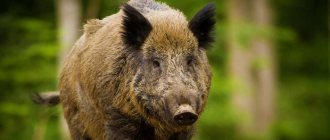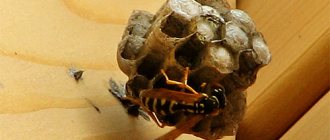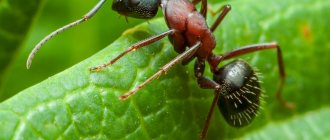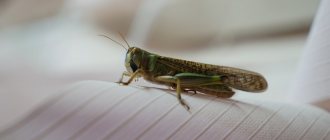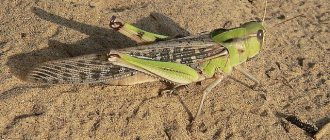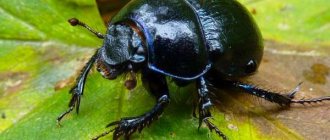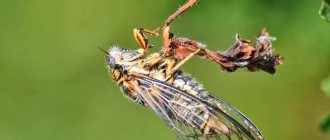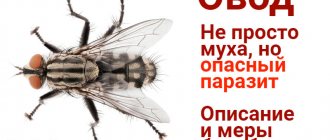Origin of the species and description
Photo: Osa
Wasps do not have a clear scientific definition. This is the customary name for all stinging stalked-bellied insects from the order Hymenoptera, which do not belong to bees or ants. Today there is a huge variety of different wasps. Insects of this type include the following wasps: road wasps, glitter wasps, sand wasps, skolia wasps, paper wasps, flower wasps, hornets, burrowing wasps, and many others.
All of them are conventionally divided into two categories:
- Singles;
- Public.
Interesting fact: Unlike bees, wasps can defend themselves not only with the help of a sting. If their existence is threatened, insects can use the jaw apparatus. Their bite is quite sensitive.
The solitary wasp leads a solitary life and builds an unusual nest. All adults are capable of reproduction. If nests are built, then in very secluded corners: on walls, on a tree, in the soil. And only a small number of species prefer to live without nests. They rest in natural holes in the wood.
Social wasps prefer to live in families. Their nests are built by the queen. Not all adults are capable of reproduction. Sometimes a colony can number several thousand wasps, but only one of them can reproduce. Infertile wasps are called workers, fertile ones are called queens.
Interesting fact: Most Hymenoptera can transition from a solitary to a social lifestyle. This transition takes place in several stages.
Habitat
All wasps are divided into two groups - social and solitary. Their habitat differs depending on their lifestyle.
Social individuals live in nests and hives. They choose their habitat depending on how much material there is nearby for building a home. Insects also try to settle in places where there is a lot of food.
The hive can be formed in the crown of trees or thickets of bushes. Some species build homes in dense grass or in the ground. They also choose human dwellings for nests. Wasps can settle on the balcony, attic, and also on the roof of the house. They often choose barns and garages for hives.
Solitary individuals, unlike social ones, do not have a permanent place of residence. They spend the night in the grass and on flowers. To stay on the plant, insects cling to it with their jaws or paws. At dawn, single birds fly to a new place.
Appearance and features
Photo: Insect wasp
The wasp is a bright, interesting insect. It has a very characteristic color - yellow and black stripes. The adult size is average - up to ten centimeters. Only females can reach eighteen centimeters in length. The body of this animal has many small hairs. There is a sting at its end. It is short, very smooth, and easily penetrates the victim. The sting has the ability to move, so the wasp can bite from almost any position.
Video: Wasp
The wasp has eyes of a complex structure. They are large and can distinguish objects at 180C. Three eyes are located on the top of the head. They are difficult to notice right away. Near these eyes there are antennae. The functions of the antennae depend on the activity of the animal and the specific situation. Usually this part of the body serves as a reference point for flight. With their help, the wasp can accurately determine the direction of the wind, the depth of the gap and much more.
Interesting fact: The sting of representatives of the wasp species does not have serrations. Unlike bees, these animals are not injured when stung.
Wasps is a collective name. There are many types of wasps, and their external characteristics vary slightly.
Let's look at a brief external description of the most common types:
- Paper. They look the most familiar. They settle near humans and are black and yellow in color;
- Spangled wasps. They have average sizes - up to eight centimeters. The color of the body is unusual - pearlescent, pink or turquoise;
- Floral. They are tiny in size. They do not grow more than one centimeter. The predominant color is yellow;
- German wasps. They have an unusual body color – bright orange. Males of this species are black and orange and have black wings. Females do not have wings and are often called velvet ants.
Features of the structure of the insect wasp
The classic insect wasp resembles a bee in appearance, but is distinguished by a large variability in the size of its yellow-black striped body - from one and a half centimeters to ten.
Adults have four membranous wings and a barrel-shaped or fusiform abdomen covered with hairs. On the head of the insect there are large eyes that have a special structure and make it possible to look in different directions at the same time.
Also on the head of the wasp you can see special antennae, which replace several organs at once: smell, taste and touch. With the help of these devices, the insect is able to build a house for itself by measuring the size of the cells. The wasp's powerful jaws easily process plant matter, turning it into food or nesting material. Wasp sting and the danger of a bite
One of the interesting features of the wasp, which distinguishes it from other insects of a similar species, is its flexibility. The elongated body with a very narrow “waist” can be folded almost in half, allowing you to bite from any position.
The wasp's sting is located at the end of the body and serves as a source of poison. Typically, when attacking an insect, it uses not only its sting, but also its jaws, the bite of which is very painful. Wasp venom is incredibly dangerous for people prone to allergies. In some cases, it can cause respiratory arrest and death.
Where does the wasp live?
Photo: Animal wasp
Representatives of wasps are widespread throughout the world. They can easily be found in Belarus, Russia, Ukraine, Europe, Africa, Argentina, Canada, Mexico, Australia, China, Japan. Such animals do not live only in the hot Sahara, the Arctic and the Arabian Peninsula. Wasps prefer a temperate climate and cannot exist in regions that are too hot or too frosty.
Interesting fact: A very dangerous species of wasp lives in Japan and China - the Asian hornet. Its size can reach six centimeters. One bite of such an insect is quite enough to kill a person, especially if he is allergic. According to statistics, up to fifty people die every year from the sting of the Asian hornet in these countries.
Most representatives of wasps live in the Northern Hemisphere. Only a small population can be found in Brazil. These insects choose their habitat according to several criteria: temperate climate, presence of trees, humans. The thing is that the human habitat makes it easier for wasps to get their food. The tree is used for building nests and raising larvae. Some individuals build homes from clay and pebbles. Their nests look very much like small castles.
Wasp insect habitats
Wasps are considered one of the most common insects on the planet. They are widespread not only in all Russian regions, but also in Europe, northern Africa, Canada, the Australian continent, and Latin American countries.
They are absent only in the Sahara Desert, the countries of the Arabian Peninsula and in Arctic and Antarctic ice.
What does a wasp eat?
Photo: Osa
The diet of representatives of the wasp species is quite varied. It depends on several factors: type of animal, stage of development, habitat. It may seem that these insects are not at all selective in food. They can eat sweets, fish, fruit, berries and even candy. However, this is not the main food of wasps, but only a pleasant addition to the diet.
Most species prefer soft, liquid food. They feed on the pulp of a variety of fruits, plant juice, berries and nectars. If the opportunity arises, the wasp will not mind eating a little jam, honey or sweet drink. Wasps have a very developed sense of smell. Therefore, they can easily find fermented or rotten fruits. They are also attracted by the pungent smell of beer and kvass. Wasps bring part of their prey to their offspring, the queen. This is what the workers do.
Predator wasps have a slightly different diet. They mainly eat insects: beetles, flies, cockroaches, small spiders. This is what they feed their offspring. The hunting process of a predator wasp is quite interesting. First she looks out for a potential victim, then suddenly attacks. The hymenoptera insect tries to insert its sting into its prey as quickly as possible in order to paralyze it. The poison helps keep the meat fresh.
Features of insect nutrition wasp
According to the way they feed, all wasps can be divided into two main groups:
- herbivores;
- predators.
The first group is quite harmless and eats pollen, juice of berries and fruits, and sweet and sticky secretions of aphids.
Predators are quite aggressive. They attack spiders, beetles and large insects. They also look for various types of larvae in the ground. Carnivorous representatives of the wasp family attack the victim and immobilize it with their poisonous sting. The poison does not kill potential food, but only immobilizes it, preserving it for a long time.
Features of character and lifestyle
Photo: Bumblebee Wasp
The lifestyle of this animal depends on the species. The life of solitary wasps can be called monotonous. They are actively engaged in preparing reserves for offspring. To do this, they place the paralyzed prey in the nest so that the larvae can feed on it. Further, the offspring will develop independently, without the help of their parents.
Social wasps live more interesting lives. In the spring, the queen looks for a place to create a “house”. There she lays eggs. When the larvae appear, the queen takes care of them. The first brood grows up over time and relieves its parent of worries. They take on all the responsibilities for obtaining food and building a house. The queen continues to increase the number of colonies.
There is an opinion that stinging insects spend the night sleeping. But that's not true! These animals never sleep. With the onset of darkness, their natural activity simply decreases. Wasps prefer to spend their nights in their nests, chewing bark. When morning comes, the adults begin building new honeycombs.
Interesting fact: The lifespan of males usually does not exceed two weeks. Male wasps die soon after mating.
The character of most representatives of this species is very bad. Wasps are not the first to attack without doing anything, but they will definitely sting if you disturb them even a little. In this case, the smell of the secreted poison can be smelled by relatives of the insect. Then the person or animal who disturbed the wasp will be in big trouble. Wasps can band together and face danger together.
Harm and benefit
People's attitude towards wasps is dictated by some natural fear of stinging insects. They are afraid of them and try to avoid a chance meeting. The precaution is well justified!
Some species like pompilidae are truly dangerous. The strong poison can cause anaphylactic shock in people sensitive to it.
But even without an acute allergic reaction, a bite does not bode well. Soreness and swelling at the site of the bite lasts for three days. In difficult cases, an appointment is required
painkillers.
It is necessary to take precautions - for example, do not try to drive away the insect by waving your hands. And in the forest you should always wear thick clothing and, most importantly, look carefully around you so as not to inadvertently disturb a wasp’s nest.
In general, equestrians are peaceful towards humans. After all, they are interested in other insects, and not the human body. It must not be forgotten that the reduction in the number of many agricultural pests is the merit of these insects, which are unpleasant at first glance.
Social structure and reproduction
Photo: Insect wasp
In winter, adults are constantly in shelter. To do this, they find a secluded place for themselves in advance. With the onset of spring, with the first warmth, the queen flies out in search of a suitable place to build a nest. The nest is necessary so that the female can lay eggs there and raise her offspring. Tree bark, clay, stones and other natural materials are used for construction.
The first eggs hatch into sterile individuals. They will continue to build a home and bring food for the queen's future offspring. Only at the end of summer do offspring appear that are capable of reproducing their own kind. It is this that will mate in the future. After fertilization, the females will look for a place for a warm winter, and the males will soon die a natural death.
One female wasp can reproduce about two thousand individuals. Most of them will be infertile. The uterus seals the laid eggs in a special chamber. She also places small insects there. The larvae will feed on these insects in the future and soon turn into adults. The larvae, which will be able to reproduce in the future, have a completely different diet. They are fed food that promotes the development of sexual organs. The queen lives for about ten months, while sterile wasps only live for four weeks.
Fat burner Cloma Pharma Red Wasp reviews
“What can I say? When I decided to buy it, I couldn’t find almost a single detailed review, so maybe mine will help someone) In general, I took 2 capsules a day. I was very afraid of side effects, hand tremors, since I drive a car every morning, plus I was afraid of tacardia and in general everything related to the heart, but as it turned out, nothing bad happened. I came to work, I had a lot of energy, I didn’t sweat a ton, which is strange. After work I went to training, cardio + strength training, did more than usual and was less tired. Here the sweat was already pouring in a stream! But what was pleasing was that again there was no such cardia or other unpleasant side effects. It took about 3 kilos in two weeks, let's see what happens next. But I have high hopes for him."
“In short, I tried it in every different way! 1. excluded all stimulants, even tea and coffee. I took 2 capsules a day. Worked great, no headaches, no nausea, no side effects noticed. There was a lot of energy, but not enough for hardcore training. By the way, I noticed that I sweat a lot, even just sitting in a chair.
2. 2 capsules per day of the burner + a couple of cups of coffee per day, before training, a caffeine capsule. I don’t advise unprepared people to do this at all! I drank the first capsule in the morning, washed it down with coffee and my heart jumped out of my chest. Half an hour passed, but it scared me. Then I drank the capsule and coffee at intervals of half an hour. Everything was fine. There is noticeably more energy, enough for training. after the training it was enough, but I couldn’t fall asleep for an hour and a half afterwards.
So, I will conclude that the burner is quite strong and does not even require additional stimuli. But I think tea and coffee can not be excluded, just drink in moderation. It accelerates well, the fat has also noticeably decreased, and it drains the water. Good new product, worthy"
Reviews of Red Wasp 25 also advise taking one capsule in the morning and the second before training instead of your pre-workout.
Natural enemies of wasps
Photo: Wasp animal
Wasps, especially social species, are collective animals. Together they can hold the defense when attacked by the enemy.
However, even wasp colonies have natural enemies:
- Some types of birds. Only certain species of birds dare to attack stinging insects. In particular, European honey buzzards prey on wasps. They catch them in flight and immediately tear off the sting. The carcass is then given to its chicks. Bee-eaters are not averse to eating wasps. They easily catch them, crush them and quickly swallow them. At the same time, they themselves never receive any damage;
- Small parasites. They start right in wasp nests. Small ticks, “riders”, feed on young animals that still live in the honeycombs. Such parasites can go unnoticed by adults for a very long time. They significantly reduce the number of young animals;
- Wild animals. Wasps need to be wary of hedgehogs, bears, and other medium and large wild predators. However, most animals that have been bitten by this insect at least once try to avoid it in the future;
- People. If a wasp colony settles near a house, in a barn or in an attic, it will almost always die. People, on their own or with the help of specialists, try to get rid of the nest and wasps using various means and poison.
Wasp sting and its possible consequences
A wasp sting is considered the second most painful among insect bites in general. The only thing that can bite even more painfully is the South American bullet ant. However, in our latitudes, the wasp is the most aggressive insect, an encounter with which can lead to unpredictable consequences. Feeling a threat, the wasp violently attacks the enemy and is capable of biting several times in a row - as long as the reserves of poison last. This explosive mixture can be enough for 5-6 bites.
Wasp venom is a complex and dangerous cocktail of a large number of different substances:
- phospholipases – cause destruction of cell walls, tumor and inflammation;
- melitin – destroys mast cells;
- apamin is a toxin that has a strong effect on the motor nerves and the entire nervous system as a whole;
- acetylcholine – negatively affects the conduction of nerve impulses;
- histamine – triggers allergic reactions in the body;
- MCD-peptide – promotes an avalanche-like increase in the amount of histamine in the blood;
Moreover, in different representatives of even the same species, the ratio of the components of the poison is extremely individual, and therefore the reaction to a bite cannot be the same. And if we also take into account the individual characteristics of the body of the bite victim, then no one can accurately predict the consequences of the attack.
Population and species status
Photo: Osa
Wasps are a necessary, useful and significant part of the fauna. Yes, they do not produce tasty honey like bees and even harm beekeeping. However, in other areas of life and in nature, they perform a very useful task - they destroy various pests. They catch small insects and feed them to their offspring. This has a beneficial effect on plants. Garden and vegetable plantings do not suffer from the paws of pests.
For example, wasps can help completely get rid of a pest such as a mole cricket. If there is a mole cricket in the area, it is enough to attract wasps with the help of flower plants. Ground wasps will very quickly “restore order” to the area. Wasps can also be used to combat borers and leaf beetles. The following species feed on these pests: wall, paper, big-headed, big-nosed. They can significantly reduce the number of harmful insects. This is the best way to combat them without using chemicals.
Representatives of the wasp species are numerous. They are common in many countries, multiply quickly, and are able to protect themselves. Therefore, the species is not threatened by the process of extinction or extinction. However, it is impossible to track the wasp population with great accuracy. These are small insects that often settle in hard-to-reach places. For this reason, accurate population data does not exist.
Greenish glitter
This type of glitter is one of the most beautiful and colorful. The number of these insects is sharply declining. The body of greenish wasps is long - up to 9 millimeters. The color is uneven, the body has a golden hue.
This species of sparkle lives in Europe, Asia and northern Africa. Sometimes they are found in the western part of our country, in the Caucasus and northern Siberia. They live in open forest areas, forest edges, clearings and meadows. But the features of their life are not fully studied. The greenish shiner parasitizes various hymenoptera; it infects the larvae of the odiner wasp when they are about to turn into a pupa.
On chamomile petals, the glitter wasp looks even more impressive and surprising.
Main types
The wasp insect is often familiar to us from photographs. But besides the standard one with a striped yellow and black belly, there are other varieties. Wasps can be solitary or live in groups. They can also settle in different areas.
The road wasp makes a nest in the ground or even inside the corpse of a prey it has killed previously (for example, it could be a spider). The body of the dead insect will then become food for the emerging offspring.
Everyone is familiar with paper wasps, which we often see on the street in the summer. They are named so because to create nests, these species use a thin material that resembles paper in properties. And they produce it themselves, mixing their saliva with wood dust.
Wild wasps, on the contrary, settle away from people. They can often be found in the forest.
It’s interesting that a new trend has emerged today – house wasps. Some people get a dog or a cat, while others are interested in watching the life of insects. To keep such wasps, special closed aquariums are used. They are beautifully designed and look very stylish. But such a “pet,” of course, is not for everyone.
Lifestyle
In spring, black wasps collect nectar and spend the night in tree hollows, flowers, plants, and grass. In May-June, they begin to dig burrows to create offspring, which only the queen can produce. In each colony there is only one queen and all the other wasps carefully protect her.
The depth of the tunnel can be 3 cm. At the end of the hole there is a cell for the larva. To prevent anyone from getting inside the tunnel during the absence of the black wasp, it is blocked with a pebble or an earthen breast.
While hunting, the queen looks for a spider and paralyzes it with her poison. She cannot fly with a heavy load, so she drags her prey along the ground. Having placed the spider in the prepared cell, the queen lays an egg on top of the body, which after a few hours transforms into a larva.
Over the course of 2 weeks, the new individual goes through a full stage of development. During this period, the larva feeds exclusively on the prepared body of the spider, eating it gradually. First it consumes the reproductive and excretory systems, then moves on to other organs, leaving the nervous and respiratory systems at last. This is necessary so that the spider remains alive until the larva fully matures.
At the end of the cycle, a cocoon is obtained, and after a few more days the black wasp imago hatches , which prefers nectar. If the larva was laid at the end of summer, then without having time to go through the entire cycle, it can remain over the winter in the hole in the form of a pupa, so that when spring arrives, it can hatch into the world.
For each larva the queen forms a separate burrow. Blacks generally do not produce large nests. But wasps do not fly alone; if this happens, then solitary black predators are called universal. Such individuals feed on bedbugs and poisonous spiders. They are very strong and resilient.
Beautiful glitter
This species of glitter lays its eggs in the bodies of spiders that have previously been paralyzed by the poison of pelopeia. The larva of the beautiful shiner, emerging from the eggs, first eats the young pelopeia larva, and then destroys the spider. Beautiful shiners are found in Asia and Africa, and they also live in some European countries.
Splendid wasps are unusual inhabitants of meadows and fields.
Wasp wasp: is the adult dangerous?
An important question that interests people: “Does the ichneumon wasp cause harm or benefit to agriculture, and is it dangerous to humans?” A short answer can be presented in the form of the following theses:
- the insect is dangerous only for sensitive people with a high probability of an allergic reaction;
- the ichneumon wasp contributes to the destruction of garden and agricultural pests;
- the number of adults in the apiary should be limited, as they destroy bees.
All representatives of wasps bite painfully, but the species in question never attacks a person. The rider is not characterized by aggressive behavior; she always tries to avoid contact with people and disappear from their field of vision.
If the black wasp was forced to attack a person, it stings, squirting out a dose of poisonous substance. The bite feels like an ant's. Don't worry about the consequences. Adults do not use the human body to lay eggs. The ichneumon wasp may only pose a danger to sensitive people with a high likelihood of developing an allergic reaction. At the site of the bite, they develop a large red spot and swelling. In severe cases, there is a rash on the body and deterioration in health.
It is worth mentioning separately the role of the wasp for agricultural and garden crops. Adults often choose plant pests as victims. Therefore, their presence in the garden will only be beneficial. But their presence in the apiary should be limited; adults cause significant harm to bees.
Shanghai glitter
The larvae of this species develop by eating the caterpillars of the oriental moth and peach moths located in the cocoon. The female Shanghai shiner makes a small hole in the cocoon and paralyzes the insect with the help of her ovipositor. When the glitter stings the caterpillar, it stops developing. After this, the female seals the hole in the cocoon with her saliva. The larva eats the caterpillar and spins its own cocoon inside the old one.
Behind the beautiful appearance of the wasps lies a rather cruel character.
Shanghai spangles are found in South and East Asia, and the Caucasus.
